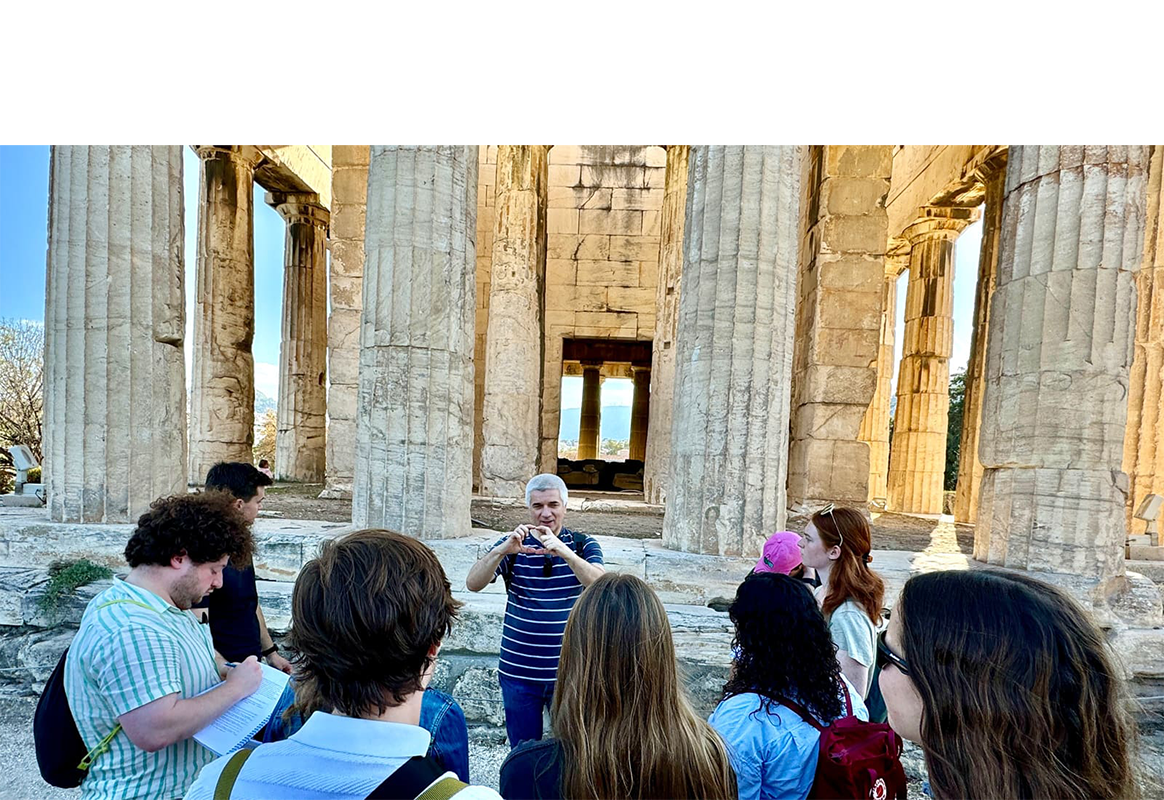“It wasn’t a very happening place,” Peter Bogucki, associate dean for undergraduate affairs at Princeton Engineering, recalled recently.
But in 1976, Bogucki, a young archaeologist, hadn’t traveled halfway across the world to a Soviet satellite state to indulge in local cinema. He had come to investigate the remains of Neolithic farming communities that had disappeared nearly 6,000 years earlier — some of the oldest and best-preserved evidence of human settlements on the European continent. The ancient settlements had been partially excavated by a Polish archaeologist nearly 50 years earlier, but since the end of World War II the site had seen scant additional archaeological work. Bogucki’s goal was to apply modern archaeological techniques like radiocarbon dating to determine the age of the artifacts found at the settlements so they could be compared with other archaeological sites in Europe. So, he set off for the settlement site accompanied by a young staff member from the archaeological museum in Łódź. What the team found at the site over the following years would change the course of Bogucki’s career and transform our understanding of human history.

“Peter is one of the most eminent scholars working in Eastern Europe on the transition from foraging to farming,” said Pam Crabtree, a professor of anthropology at New York University and one of Bogucki’s longtime collaborators. “This is one of the most significant transitions in prehistory, since it affected all aspects of ancient life, from subsistence practices to settlement patterns, technology and ideology. Peter’s work with Ryszard Grygiel at the sites of Brześć Kujawski and Osłonki was an important collaborative project that started at a time when few Western scholars were working in Eastern Europe.”
In June 2023, Bogucki was honored at a ceremony in Brześć Kujawski along with his longtime research collaborator, Ryszard Grygiel, for their contributions to archaeology and Polish history. Bogucki was named an honorary citizen of Brześć Kujawski, a distinction that speaks to Bogucki’s deep integration with the community and his role in helping to uncover its ancient heritage.
An ancient mystery
The settlement outside of Brześć Kujawski was occupied by several distinct ancient farming communities whose combined histories span more than a millennium. The older society, known as the Linear Pottery culture, settled in the area sometime around 5500 B.C., and the archaeological evidence at the site suggests that they used several species of domesticated plants and animals, including cattle, sheep, goats, pigs, barley and wheat. The younger society, known as the Brześć Kujawski Group, took up residence at the settlement several centuries later, around 4700 B.C., and belonged to a cultural group spread from Hungary to Poland. The remnants of both the Linear Pottery culture and Brześć Kujawski Group are jumbled together at the site, creating a tantalizing — and often confusing — archaeological puzzle.
Although the Brześć Kujawski settlement is not the only evidence of these cultures in Poland, it is notable for being one of the largest and most well-preserved of its kind, thanks to the favorable clay and gravel-rich soil. Bogucki found a wide variety of artifacts on his first trip to the site, including animal bones, cereal grains and flint tools. But one of the biggest curiosities were fragments of pottery containing a scattershot of small holes, which Bogucki recognized might be a sieve, although its purpose eluded him. It wasn’t until several years later when Bogucki was visiting a friend in Vermont and saw a collection of 19th-century cheese-making tools that he began to piece together what he had found several thousand miles away in Poland.
A longstanding mystery of the Brześć Kujawski settlement was why the Linear Pottery culture appeared to have raised so many cattle. The area was heavily forested at the time, which would have made for a poor grazing site if the cattle had only been raised for meat. It appeared that the pottery fragments discovered at the settlement were ancient cheese-making instruments used for straining milk curds. This would be by far the oldest evidence of cheese-making in Europe, but Bogucki lacked much in the way of evidence. The perforated pottery could also have been used for straining honey or other agricultural products. And so for years, Bogucki’s hunch remained little more than a titillating theory.
An American in Poland
Bogucki regularly returned to Poland for archaeological work over the 40 years following his initial visit to Brześć Kujawski in 1976. During this time, he watched Poland undergo a remarkable transformation as communism crumbled and the country began its long — and occasionally painful — transition to a democratic society. Aside from a brief run-in with some secret police who visited one of his archaeological digs out of curiosity, Bogucki said that he was largely left alone by the Polish communist authorities, which had generally been more permissive of American visitors compared to its many communist neighbors.
In 1989, the same year that the Polish Parliament amended its constitution to restore democracy in the country for the first time in more than 50 years, Bogucki and Grygiel — along with a team of archaeologists, students from Princeton and other universities, and workers from the local community — began excavating Osłonki, a previously unknown settlement about 7 miles west of Brześć Kujawski. The site was massive, containing some 30 houses and 90 burials, as well as the first Neolithic fortification ditch ever discovered in the country. As the magnitude of the discovery became apparent over the six subsequent summers that Bogucki and Grygiel led excavations, it began to attract international attention from archaeologists and statesmen alike. A highlight of the excavation, Bogucki says, was a visit from the U.S. ambassador to Poland, Nicholas Rey of Princeton’s Class of 1960, in 1994 to survey what he and his team had discovered.
For the next two decades, Bogucki continued to forge ahead with archaeological work around Brześć Kujawski, leveraging modern technologies such as isotopic analysis and aerial surveys to deepen our understanding of these ancient cultures. “In the mid-1980s, there were fewer than 10 sites of this period and culture known in this region. Now there’s dozens,” Bogucki said. “Aerial surveys in particular have been useful for finding traces of houses in cultivated fields, but that was the kind of work you couldn’t do under communism. You couldn’t just get in a plane and go flying around, but now you can, and archaeologists are finding these sites all over the place.”
But it was a research partnership in 2012 with Mélanie Salque, a chemist at the University of Bristol, that really brought Bogucki’s work full circle. In 2013, Salque, Bogucki, and a team of international scientists and archaeologists published a paper in Nature detailing how they had analyzed the perforated pottery shards Bogucki and others had found nearly 4 decades earlier, only to discover that they contained abundant molecular traces of milk fat. This discovery marked the oldest evidence of cheese-making in Europe by a large margin, and validated a hunch that Bogucki had nursed for decades.
The implications of these findings were profound. Aside from its direct historical significance, the fact that the ancient Linear Pottery culture was producing cheese may have been a major influence on the later development of societies across Europe. Although most humans are lactose-intolerant, cheese is somewhat lower in lactose than milk, and its early production may have allowed ancient Europeans to take advantage of dairy as a sustainable and nutrient-dense source of food. The discovery of direct evidence for the oldest cheese-making in Europe was a high point in Bogucki’s archaeological career.
At the ceremony in June before an audience including the town’s mayor, research colleagues, and several locals who had helped Bogucki excavate nearby sites as young men, Bogucki and Grygiel were presented with a special book detailing their research contributions — a tradition in European archaeology. As Bogucki remarked during his acceptance speech, he can still remember the communist party slogans painted on the walls of the forlorn rail yard that once stood in the same spot as Brześć Kujawski’s modern new cultural center. But that, he said, is ancient history.






